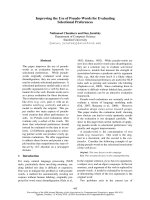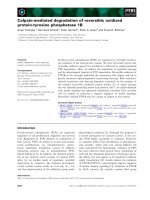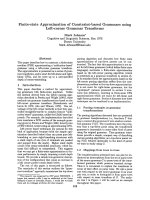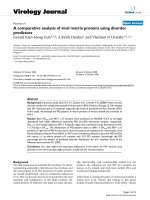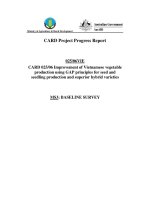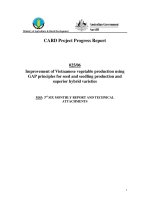Báo cáo khoa học: " Bench-to-bedside review: Amelioration of acute renal impairment using ethyl pyruvate" docx
Bạn đang xem bản rút gọn của tài liệu. Xem và tải ngay bản đầy đủ của tài liệu tại đây (55.83 KB, 5 trang )
556
IL = interleukin; iNOS = inducible nitric oxide synthase; LPS = lipopolysaccharide; NF-κB = nuclear factor-κB; TNF = tumour necrosis factor.
Critical Care December 2005 Vol 9 No 6 Reade and Fink
Abstract
Inflammation and oxidative stress cause renal impairment. Renal
failure exacerbates the effect of oxidative stress on many organ
systems. Antioxidants can prevent or treat renal failure in various
experimental models and clinical situations. Pyruvate is an
endogenous antioxidant with beneficial effects in animal models of
oxidative stress. Because sodium pyruvate rapidly degrades in
solution, a simple derivative of pyruvic acid, namely ethyl pyruvate,
has been investigated as a therapeutic agent in preclinical studies.
Ethyl pyruvate reduces organ system damage in ischaemia/
reperfusion injury and haemorrhagic and endotoxic shock, at least
in part through its antioxidant action. In addition, ethyl pyruvate
appears to have direct beneficial effects on cytokine expression
and proinflammatory gene regulation. The effect is long lasting and,
importantly, even when it is administered after the onset of
inflammation it can ameliorate organ damage and improve survival.
Ethyl pyruvate is a widely used as a food additive and was shown
to be safe in phase I clinical trials. We suggest ethyl pyruvate
warrants further evaluation in the management of acute renal
impairment.
Introduction
Acute renal failure is associated with oxidative stress [1]. This
relationship appears to be both cause and effect because
dialysis reduces markers of oxidative stress in patients with
acute renal failure [2] and various antioxidants are able to
ameliorate experimental renal injury [3,4]. Patients with
multiple organ failure have reduced antioxidant defence
mechanisms, and this effect is substantially accentuated
when acute renal failure is also present [5].
Antioxidants have been used successfully to prevent or treat
acute renal failure in humans. N-acetylcysteine attenuated
oxidative stress and nephropathy caused by intravenous
radiocontrast, and was more effective than standard
intravenous fluid prophylaxis [6]. Infrarenal abdominal aortic
aneurysm repair commonly causes ischaemia/reperfusion
injury to the kidney, producing a similar oxidative stress to that
of radiocontrast. A mixture of antioxidants (including N-
acetylcysteine, allopurinol, mannitol, and vitamins E and C)
given to patients undergoing infrarenal abdominal aortic
aneurysm repair produced a significantly better creatinine
clearance (compared with that in placebo control individuals)
48 hours postoperatively [7].
Ethyl pyruvate as an antioxidant
Pyruvate is an endogenous antioxidant and free radical
scavenger [8,9]. Sodium pyruvate scavenges H
2
O
2
via a
nonenzymatic reaction (oxidative dephosphorylation) that
yields acetate, water and carbon dioxide as products:
CH
3
COCOO
–
+ H
2
O
2
→ CH
3
COO
–
+ CO
2
+ H
2
O
In so doing, sodium pyruvate suppressed H
2
O
2
-induced lipid
peroxidation of rat kidney homogenate, and prevented
cytosolic
51
Cr release (a marker of cellular injury) by renal
epithelial cells exposed to H
2
O
2
[10]. Sodium pyruvate also
attenuated the proteinuria induced by in vivo selective renal
administration of H
2
O
2
in rats [10]. In an in vivo model of renal
failure caused by intramuscular glycerol, sodium pyruvate
reduced the rise in serum creatinine at 24 hours after glycerol
injection, prevented structural damage (as assessed by
histology) and lessened the fall in glomerular filtration rate after
glycerol injection [10]. Additionally, sodium pyruvate has
beneficial effects on other organ systems in other animal
models of redox stress (for review, see Fink [11]).
Unfortunately, the clinical utility of sodium pyruvate is limited
because it rapidly undergoes an aldol-type addition reaction
in aqueous solution to form parapyruvate. This latter
compound inhibits the oxidative decarboxylation of α-
ketoglutarate to form succinyl coenzyme A (a component of
the Krebs cycle) [11]. Ethyl pyruvate may be more stable than
pyruvate [11] and is considered safe for human consumption
Review
Bench-to-bedside review: Amelioration of acute renal
impairment using ethyl pyruvate
Michael C Reade
1
and Mitchell P Fink
2
1
Senior Registrar in Intensive Care Medicine, Austin Hospital/University of Melbourne, Heidelberg, Melbourne, Victoria, Australia
2
Professor and Chair, Department of Critical Care Medicine, Watson Professor of Surgery, University of Pittsburgh, Pittsburgh, Pennsylvania, USA
Corresponding author: M Reade,
Published online: 21 October 2005 Critical Care 2005, 9:556-560 (DOI 10.1186/cc3892)
This article is online at />© 2005 BioMed Central Ltd
557
Available online />as a food additive [12]. Ethyl pyruvate is as effective as
pyruvate (on a millimole for millimole basis) as a scavenger of
H
2
O
2
(Engert JA, Fink MP, unpublished observations),
although the rate of this reaction has not been measured.
Ethyl pyruvate has been shown to scavenge phenoxy radicals,
but the biological significance of this phenomenon is
unknown (Englert JA, Kagan VE, Fink MP, unpublished
observations). Ethyl pyruvate is more lipophilic than pyruvate
anion, and (like most esters) presumably diffuses readily into
cells, thereby acting on both intracellular and extracellular
radicals. The antioxidant potential of ethyl pyruvate with
regard to other radicals and its interactions with other oxidant
and antioxidant species in complex biological systems have
not yet been characterized. Ethyl pyruvate itself is not a free
radical.
Ethyl pyruvate has beneficial effects on a number of organ
systems when it is administered to animals subjected to
ischaemia/reperfusion injury and haemorrhagic or endotoxic
shock. For example, ethyl pyruvate reduced structural and
functional damage to intestinal mucosa caused by mesenteric
ischaemia and reperfusion [13]. It reduced hepatic necrosis
and expression of proinflammatory cytokines after partial
warm hepatic ischaemia and reperfusion [14]. In a rat model
of myocardial ischaemia/reperfusion [15] it diminished infarct
size and improved myocardial function, and in a rat model of
severe haemorrhagic shock [16] it improved survival and
ameliorated ileal mucosal permeability. In a mouse model of
resuscitated haemorrhagic shock [17] ethyl pyruvate
improved survival at 24 hours, reduced bacterial translocation
to mesenteric lymph nodes, and prevented the development
of increased ileal mucosal permeability. It prolonged survival
time and was associated with significantly lower circulating
concentrations of nitrite/nitrate and IL-6 and higher plasma
levels of IL-10 in a rats given a bolus of lipopolysaccharide
(LPS) [18]. Finally, in a murine model of acute pancreatitis
[19] ethyl pyruvate improved survival, reduced pancreatic
tumour necrosis factor (TNF) and IL-6 expression and nuclear
factor-κB (NF-κB) binding, and reduced alveolar permeability.
Only one published study to date has failed to find a
beneficial effect of ethyl pyruvate in an animal model of critical
illnesses [20]. Moderate haemorrhagic shock (involving loss
of approximately 35% blood volume) was induced in pigs and
maintained for 90 min, after which the animals were
resuscitated with Ringer’s lactate either with or without ethyl
pyruvate over the next 60–90 min. Ethyl pyruvate did not
change heart rate, mean arterial pressure, cardiac output,
oxygen delivery or uptake, or lactate concentration. At the end
of the resuscitation phase, the oxygen saturation in the
stomach and the cytoplasmic pH in the hind limb were both
significantly lower in animals given ethyl pyruvate, although
the physiological significance of this is unclear. It is possible
that the dose of ethyl pyruvate used was not adequate
(40–60% of that currently being used in a human phase II
trial of patients undergoing cardiopulmonary bypass). It may
also be that the moderate degree of haemorrhage induced
less ischaemia/reperfusion injury than in the other studies,
and that the time course over which the drug was applied,
and its effect quantified, was insufficient.
Other anti-inflammatory actions of ethyl
pyruvate
Ethyl pyruvate appears to be a more effective anti-
inflammatory agent than other antioxidants. This was apparent
when ethyl pyruvate was compared with sodium pyruvate in
lens cell culture [21], and a similar trend was observed in an
in vivo model of rat mesenteric ischaemia and reperfusion
[13]. Treatment with ethyl pyruvate was more effective than
sodium pyruvate in preventing the proinflammatory cytokine
stimulated hyperpermeability and induction of inducible nitric
oxide synthase (iNOS) in Caco-2 human enterocyte-like
monolayers in vitro, and in protecting against ileal mucosal
hyperpermeability, bacterial translocation and hepatocellular
injury in mice given LPS in vivo [22].
The enhanced anti-inflammatory effect of ethyl pyruvate is
probably due to its ability to modulate cytokine expression
and proinflammatory gene regulation, in addition to the
biochemical antioxidant properties described above. For
example, rats given a bolus of LPS had raised plasma levels
of IL-6 and lower levels of IL-10, an effect that was reversed
by ethyl pyruvate [18]. Also, treatment with ethyl pyruvate
initiated 24 hours after caecal puncture in mice significantly
increased survival (from 30% to 88%). In animals with
established endotoxaemia or sepsis, ethyl pyruvate treatment
significantly reduced circulating levels of the newly
recognized late-phase proinflammatory cytokine high mobility
group 1 (HMGB1). In macrophage cultures, ethyl pyruvate
specifically inhibited activation of p38 mitogen-activated
protein kinase and NF-κB, two signalling pathways that are
critical for cytokine release [23].
Additional effects of ethyl pyruvate have been described. In
RAW 264.7 murine macrophage-like cells, stimulation with
LPS led to an increase in glutathione concentration [24].
Contrary to what might be expected based on its antioxidant
properties, ethyl pyruvate blocks this effect [24].
Extramitochondrial glutathione depletion is known to alter the
thiol-disulfide redox state, which in murine hepatocytes
inhibited nuclear binding of NF-κB and subsequent
expression of iNOS [25]. More recently, ethyl pyruvate was
shown to reduce NF-κB DNA binding in RAW 264.7
macrophages, which similarly reduced LPS-induced iNOS
expression and luciferase reporter gene function [26]. The
mechanism of this effect was further explored. IκB
degradation was unaffected. However, ethyl pyruvate directly
inhibited binding of the p65 subunit of NF-κB to DNA while
having no effect on the p50 subunit.
It is possible that ethyl pyruvate inhibits activation of NF-κB
simply by scavenging H
2
O
2
. However, several observations
558
Critical Care December 2005 Vol 9 No 6 Reade and Fink
suggest that ethyl pyruvate mediated inhibition of NF-κB
activation may entail more than an antioxidant effect. First,
oxidative stress (1–10 mmol/l H
2
O
2
) fails to activate NF-κB in
Caco-2 [27] or DLD-1 [28] enterocyte-like cells, but ethyl
pyruvate blocks activation of NF-κB in cytomix-stimulated
Caco-2 cells [29]. Second, other well known scavengers of
reactive oxygen species, such as pyrollodine dithiocarbamate
and dimethyl sulfoxide, fail to block IL-1β induced NF-κB
activation in Caco-2 cells [27], but ethyl pyruvate effectively
inhibits cytomix-induced NF-κB activation in the same cell line
[29]. Third, N-acetylcysteine, an effective reactive oxygen
species scavenger, fails to inhibit activation of NF-κB induced
by TNF or IL-1β in ECV304 endothelial cells [30]. N-acetyl-
cysteine also fails to block LPS-induced NF-κB activation in
J774.1 murine macrophage-like cells [31]. In contrast, ethyl
pyruvate inhibits activation of NF-κB induced by cytomix
(TNF, IL-1β and interferon-γ) in Caco-2 cells [29] or by LPS in
RAW 264.7 murine macrophage-like cells [23]. Indeed, when
Song and coworkers [24] carried out a head-to-head
comparison of ethyl pyruvate and N-acetylcysteine in
experiments using LPS-stimulated RAW 264.7 cells, ethyl
pyruvate was clearly a more potent inhibitor of NF-κB DNA
binding when the two compounds were compared on a
millimole for millimole basis. These data support the view that
ethyl pyruvate has anti-inflammatory effects that are
independent of its antioxidant properties.
Timing of administration of ethyl pyruvate
As might be expected following inhibition of NF-κB DNA
binding, the effects of ethyl pyruvate appear to persist for
some time. Pretreatment of mice with ethyl pyruvate, with the
last dose 6 hours before injection of LPS, was almost as
effective at preventing hepatic iNOS mRNA expression and
circulating nitrite/nitrate as was ethyl pyruvate given both
before and after the insult. A similar durability of effect was
seen with ethyl pyruvate pretreatment of Caco-2 cells in vitro,
even when the cells were washed extensively to remove the
compound [22]. The durability of the anti-inflammatory effects
of ethyl pyruvate in these studies constitutes another piece of
evidence in support of the view that this compound exerts
anti-inflammatory actions via one or more mechanisms that do
not depend on scavenging of H
2
O
2
or other reactive oxygen
species. In order to react preferentially with reactive oxygen
species, a scavenger must be present in cells when these
compounds are being formed. However, transient exposure
of cells to ethyl pyruvate (followed by washing to remove the
compound) confers durable protection against a subsequent
proinflammatory stimulus, making it unlikely that scavenging
of reactive oxygen species is the underlying mechanism.
Most importantly, from a clinical standpoint ethyl pyruvate
appears to retain beneficial effects even when it is given after
a proinflammatory stimulus has become well established. In
the study conducted by Miyaji and coworkers [32] ethyl
pyruvate, even when given at 6 or 12 hours after caecal
ligation and puncture, decreased injury in many organs (liver,
pancreas, muscle and kidney) when assessed at 24 hours.
Similarly in mice, LPS-induced ileal mucosal hyperper-
meability, bacterial translocation to mesenteric lymph nodes
and hepatocellular injury were reduced to a similar extent by
ethyl pyruvate (compared with Ringer’s lactate solution),
regardless of whether it was given 1 hour or 6 hours after
LPS injection. These beneficial effects on organ system
function translate to mortality benefits; ethyl pyruvate reduced
mortality in mice that underwent caecal ligation and puncture,
even when treatment with the compound was started
24 hours after the operation [23].
Ethyl pyruvate and renal failure
Ethyl pyruvate decreases sepsis-induced acute renal failure in
vivo. Mice subjected to caecal ligation and puncture
developed multiple organ failure (as indicated by increased
circulating levels of several enzymes, including aspartate
aminotransferase, alanine aminotransferase, lactate dehydro-
genase, creatine kinase and amylase) and a biphasic rise in
serum TNF concentration, despite fluid resuscitation and
treatment with broad spectrum antibiotics. Circulating
creatinine concentrations were also reproducibly increased,
with histological evidence of tubular damage. A single dose
of intraperitoneal ethyl pyruvate immediately after surgery
partially inhibited muscle, liver and pancreatic injury. Renal
function was also substantially protected, as indicated by
lower plasma urea and creatinine levels, as well as reduced
histological tubular damage. Furthermore, ethyl pyruvate
inhibited the induction of mRNA for TNF, tissue factor,
plasminogen activator inhibitor-1 and tissue plasminogen
activator, all of which are believed to have deleterious effects
in sepsis [32]. In a more recent study from the same
laboratory [33] ethyl pyruvate reversed renal dysfunction in
aged mice 20 hours after caecal ligation and puncture, as
detected by dendrimer-enhanced magnetic resonance
imaging.
Possible adverse effects of ethyl pyruvate
Attenuation of inflammation in sepsis may well be a double-
edged sword, because inflammation is integral to host
defences against infection. In this regard, the enhancement of
immune function in a rat model of burn injury is encouraging.
Rats given intraperitoneal ethyl pyruvate 6 hours after a 30%
full-thickness burn did not exhibit the reduction in splenic
lymphocyte proliferation rate at days 1–7 that was observed
in control animals [34]. Ethyl pyruvate also enhanced IL-2
production. While reducing nonspecific inflammation, it
appears that ethyl pyruvate can also enhance specific cell-
mediated immunity by an as yet unexplored mechanism.
Ethyl pyruvate is unlikely to be harmful to humans, given its
close similarity to an endogenous metabolite, its safety profile
in animals and its common use as a food supplement in
humans. Phase I clinical studies carried out by Critical
Therapeutics, Inc. (Lexington, MA, USA) confirm the safety of
ethyl pyruvate. The results of these studies have not been
559
reported by the company in the peer-reviewed literature but
were submitted to the US Food and Drug Administration.
Since the Food and Drug Administration has permitted the
company to carry out a phase II randomized controlled trial of
ethyl pyruvate in high-risk patients undergoing cardiac
surgery and cardiopulmonary bypass [35], major safety
concerns apparently were not raised by the agency.
Conclusion
It would seem from these animal and cellular models that ethyl
pyruvate reduces oxidative stress and the damage done by
oxygen free radicals in a variety of tissues. All of the in vivo
models in which survival was examined have shown ethyl
pyruvate to have a beneficial effect. Two studies specifically
demonstrated a beneficial effect in acute renal failure, even
when the drug was given at a relatively advanced stage in the
disease. The kidneys are particularly sensitive to oxidative
stress and the deleterious effects of excessive inflammation,
usually being the first organ system after the lungs to exhibit
clinical and biochemical signs of impairment in critical illness.
Accordingly, we believe that ethyl pyruvate warrants evaluation
in a clinical trial for the prevention and/or amelioration of acute
renal failure in high-risk intensive care patients.
Competing interests
MPF is a cofounder of and a consultant to Critical
Therapeutics, Inc., a biotechnology company that is developing
several compounds, including ethyl pyruvate, as therapeutic
agents. MPF receives funds from Critical Therapeutics. Critical
Therapeutics holds the patient for ethyl pyruvate.
Acknowledgements
We thank Professor Rinaldo Bellomo, Department of Intensive Care
Medicine, Austin Hospital/University of Melbourne, for his helpful sug-
gestions during the preparation of this manuscript.
References
1. Himmelfarb J, McMonagle E, Freedman S, Klenzak J, McMenamin
E, Le P, Pupim L, Ikizler T: Oxidative stress is increased in criti-
cally ill patients with acute renal failure. J Am Soc Nephrol
2004, 15:2449-2456.
2. Balakrishnan VS, Blumberg J, Pereira BJ, Jaber BL: Antioxidant
and oxidative stress indices in dialysis-dependent acute renal
failure. Blood Purif 2003, 21:213-219.
3. Maldonado PD, Barrera D, Rivero I, Mata R, Medina-Campos ON,
Hernandez-Pando R, Pedraza-Chaverri J: Antioxidant S-allylcys-
teine prevents gentamicin-induced oxidative stress and renal
damage. Free Radic Biol Med 2003, 35:317-324.
4. Chander V, Singh D, Chopra K: Catechin, a natural antioxidant
protects against rhabdomyolysis-induced myoglobinuric
acute renal failure. Pharmacol Res 2003, 48:503-509.
5. Metnitz GH, Fischer M, Bartens C, Steltzer H, Lang T, Druml W:
Impact of acute renal failure on antioxidant status in multiple
organ failure. Acta Anaesthesiol Scand 2000, 44:236-240.
6. Baker CS, Wragg A, Kumar S, De Palma R, Baker LR, Knight CJ:
A rapid protocol for the prevention of contrast-induced renal
dysfunction: the RAPPID study. J Am Coll Cardiol 2003, 41:
2114-2118.
7. Wijnen MH, Vader HL, Van Den Wall Bake AW, Roumen RM:
Can renal dysfunction after infra-renal aortic aneurysm repair
be modified by multi-antioxidant supplementation? J Cardio-
vasc Surg 2002, 43:483-488.
8. O’Donnell-Tormey J, Nathan CF, Lanks K, DeBoer CJ, de la Harpe
J: Secretion of pyruvate. An antioxidant defense of mam-
malian cells. J Exp Med 1987, 165:500-514.
9. Brand KA, Hermfisse U: Aerobic glycolysis by proliferating
cells: a protective strategy against reactive oxygen species.
FASEB J 1997, 11:388-395.
10. Salahudeen AK, Clark EC, Nath KA: Hydrogen peroxide-
induced renal injury. A protective role for pyruvate in vitro and
in vivo. J Clin Invest 1991, 88:1886-1893.
11. Fink MP: Ethyl pyruvate: a novel anti-inflammatory agent. Crit
Care Med 2003, Suppl:S51-S56.
12. Food and Agriculture Organization of the United Nations and the
World Health Organization: Summary of Evaluations performed
by the Joint FAO/WHO expert committee on food additives.
[ />13. Sims CA, Wattanasirichaigoon S, Menconi MJ, Ajami AM, Fink
MP: Ringer’s ethyl pyruvate solution ameliorates
ischemia/reperfusion-induced intestinal mucosal injury in
rats. Crit Care Med 2001, 29:1513-1518.
14. Tsung A, Kaizu T, Nakao A, Shao L, Bucher B, Fink MP, Murase N,
Geller DA: Ethyl pyruvate ameliorates liver ischemia-reperfu-
sion injury by decreasing hepatic necrosis and apoptosis.
Transplantation 2005, 79:196-204.
15. Woo YJ, Taylor MD, Cohen JE, Jayasankar V, Bish LT, Burdick J,
Pirolli TJ, Berry MF, Hsu V, Grand T: Ethyl pyruvate preserves
cardiac function and attenuates oxidative injury after pro-
longed myocardial ischemia. J Thorac Cardiovasc Surg 2004,
127:1262-1269.
16. Tawadrous ZS, Delude RL, Fink MP: Resuscitation from hemor-
rhagic shock with Ringer’s ethyl pyruvate solution improves
survival and ameliorates intestinal mucosal hyperpermeability
in rats. Shock 2002, 17:473-477.
17. Yang R, Gallo DJ, Baust JJ, Uchiyama T, Watkins SK, Delude RL,
Fink MP: Ethyl pyruvate modulates inflammatory gene expres-
sion in mice subjected to hemorrhagic shock. Am J Physiol
Gastrointest Liver Physiol 2002, 283:G212-G221.
18. Venkataraman R, Kellum JA, Song M, Fink MP: Resuscitation
with Ringer’s ethyl pyruvate solution prolongs survival and
modulates plasma cytokine and nitrite/nitrate concentrations
in a rat model of lipopolysaccharide-induced shock. Shock
2002, 18:507-512.
19. Yang R, Uchiyama T, Alber SM, Han X, Watkins SK, Delude RL,
Fink MP: Ethyl pyruvate ameliorates distant organ injury in a
murine model of acute necrotizing pancreatitis. Crit Care Med
2004, 32:1453-1459.
20. Mulier KE, Beilman GJ, Conroy MJ, Taylor JH, Skarda DE, Hammer
BE: Ringer’s ethyl pyruvate in hemorrhagic shock and resus-
citation does not improve early hemodynamics or tissue ener-
getics. Shock 2005, 23:248-252.
21. Varma SD, Devamanoharan PS, Ali AH: Prevention of intracellu-
lar oxidative stress to lens by pyruvate and its ester. Free
Radic Res 1998, 28:131-135.
22. Sappington PL, Fink ME, Yang R, Delude RL, Fink MP: Ethyl
pyruvate provides durable protection against inflammation-
induced intestinal epithelial barrier dysfunction. Shock 2003,
20:521-528.
23. Ulloa L, Ochani M, Yang H, Tanovic M, Halperin D, Yang R, Czura
CJ, Fink MP, Tracey KJ: Ethyl pyruvate prevents lethality in
mice with established lethal sepsis and systemic inflamma-
tion. Proc Natl Acad Sci USA 2002, 99:12351-12356.
24. Song M, Kellum JA, Kaldas H, Fink MP: Evidence that glu-
tathione depletion is a mechanism responsible for the anti-
inflammatory effects of ethyl pyruvate in cultured
lipopolysaccharide-stimulated RAW 264.7 cells. J Pharmacol
Exp Ther 2004, 308:307-316.
25. Matsumaru K, Ji C, Kaplowitz N: Mechanisms for sensitization
to TNF-induced apoptosis by acute glutathione depletion in
murine hepatocytes. Hepatology 2003, 37:1425-1434.
26. Han Y, Englert JA, Yang R, Delude RL, Fink MP: Ethyl pyruvate
inhibits nuclear factor-kappaB-dependent signaling by
directly targeting p65. J Pharmacol Exp Ther 2005, 312:1097-
1105.
27. Parikh AA, Moon MR, Pritts TA, Fischer JE, Szabo C, Hasselgren
P-O, Salzman AL: IL-1beta induction of NF-kappaB activation
in human intestinal epithelial cells is independent of oxyradi-
cal signaling. Shock 2000, 13:8-13.
28. Salzman AL, Denenberg AG, Ueta I, O’Connor M, Linn SC, Szabo
C: Induction and activity of nitric oxide synthase in cultured
human intestinal epithelial monolayers. Am J Physiol 1996,
270:G565-G573.
Available online />560
Critical Care December 2005 Vol 9 No 6 Reade and Fink
29. Sappington PL, Han X, Yang R, Delude RL, Fink MP: Ethyl pyru-
vate ameliorates intestinal epithelial barrier dysfunction in
endotoxemic mice and immunostimulated Caco-2 enterocytic
monolayers. J Pharmacol Exp Ther 2003, 304:464-476.
30. Bowie AG, Moynagh PN, O’Neill LAJ: Lipid peroxidation is
involved in the activation of NF-kappa B by tumor necrosis
factor but not interleukin-1 in the human endothelial cell line
ECV304. J Biol Chem 1997, 272:25941-25950.
31. Chandel NS, Trzyna WC, McClintock DS, Schumacker PT: Role
of oxidants in NF-kappa B activation and TNF-alpha gene
transcription induced by hypoxia and endotoxin. J Immunol
2000, 165:1013-1021.
32. Miyaji T, Hu X, Yuen PS, Muramatsu Y, Iyer S, Hewitt SM, Star
RA: Ethyl pyruvate decreases sepsis-induced acute renal
failure and multiple organ damage in aged mice. Kidney Int
2003, 64:1620-1631.
33. Dear JW, Kobayashi H, Jo SK, Holly MK, Hu X, Yuen PS, Brech-
biel MW, Star RA: Dendrimer-enhanced MRI as a diagnostic
and prognostic biomarker of sepsis-induced acute renal
failure in aged mice. Kidney Int 2005, 67:2159-2167.
34. Dong YQ, Yao YM, Wei P, Liu H, Dong N, Yu Y, Sheng ZY:
Effects of ethyl pyruvate on cell-mediated immune function in
rats with delayed resuscitation after burn injury [in Chinese].
Zhongguo Wei Zhong Bing Ji Jiu Yi Xue 2005, 17:12-15.
35. US National Library of Medicine: CTI-01 (ethyl pyruvate) safety
and complication prevention in cardiac surgery patients on
cardiopulmonary bypass (CPB). [ />ct/gui/show/NCT00107666]



